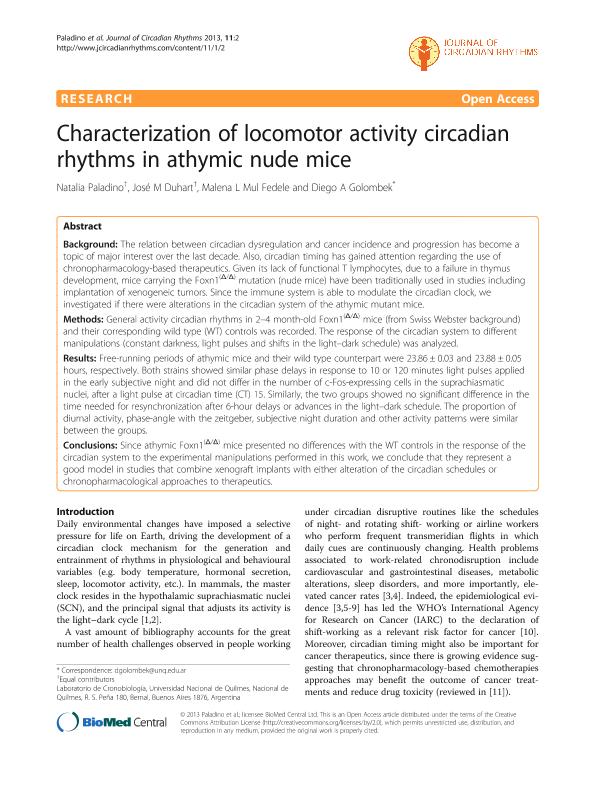Mostrar el registro sencillo del ítem
dc.contributor.author
Paladino, Natalia

dc.contributor.author
Duhart, José Manuel

dc.contributor.author
Mul Fedele, Malena Lis

dc.contributor.author
Golombek, Diego Andrés

dc.date.available
2017-08-24T19:40:29Z
dc.date.issued
2013-02
dc.identifier.citation
Paladino, Natalia; Duhart, José Manuel; Mul Fedele, Malena Lis; Golombek, Diego Andrés; Characterization of locomotor activity circadian rhythms in athymic nude mice; BioMed Central; Journal of Circadian Rhythms; 11; 1; 2-2013; 2-19
dc.identifier.issn
1740-3391
dc.identifier.uri
http://hdl.handle.net/11336/22955
dc.description.abstract
BACKGROUND: The relation between circadian dysregulation and cancer incidence and progression has become a topic of major interest over the last decade. Also, circadian timing has gained attention regarding the use of chronopharmacology-based therapeutics. Given its lack of functional T lymphocytes, due to a failure in thymus development, mice carrying the Foxn1(Δ/Δ) mutation (nude mice) have been traditionally used in studies including implantation of xenogeneic tumors. Since the immune system is able to modulate the circadian clock, we investigated if there were alterations in the circadian system of the athymic mutant mice. METHODS: General activity circadian rhythms in 2-4 month-old Foxn1(Δ/Δ) mice (from Swiss Webster background) and their corresponding wild type (WT) controls was recorded. The response of the circadian system to different manipulations (constant darkness, light pulses and shifts in the light-dark schedule) was analyzed. RESULTS: Free-running periods of athymic mice and their wild type counterpart were 23.86 ± 0.03 and 23.88 ± 0.05 hours, respectively. Both strains showed similar phase delays in response to 10 or 120 minutes light pulses applied in the early subjective night and did not differ in the number of c-Fos-expressing cells in the suprachiasmatic nuclei, after a light pulse at circadian time (CT) 15. Similarly, the two groups showed no significant difference in the time needed for resynchronization after 6-hour delays or advances in the light-dark schedule. The proportion of diurnal activity, phase-angle with the zeitgeber, subjective night duration and other activity patterns were similar between the groups. CONCLUSIONS: Since athymic Foxn1(Δ/Δ) mice presented no differences with the WT controls in the response of the circadian system to the experimental manipulations performed in this work, we conclude that they represent a good model in studies that combine xenograft implants with either alteration of the circadian schedules or chronopharmacological approaches to therapeutics.
dc.format
application/pdf
dc.language.iso
eng
dc.publisher
BioMed Central

dc.rights
info:eu-repo/semantics/openAccess
dc.rights.uri
https://creativecommons.org/licenses/by/2.5/ar/
dc.subject
Circadian Rhythms
dc.subject
Cancer
dc.subject
Nude Mice
dc.subject.classification
Bioquímica y Biología Molecular

dc.subject.classification
Ciencias Biológicas

dc.subject.classification
CIENCIAS NATURALES Y EXACTAS

dc.title
Characterization of locomotor activity circadian rhythms in athymic nude mice
dc.type
info:eu-repo/semantics/article
dc.type
info:ar-repo/semantics/artículo
dc.type
info:eu-repo/semantics/publishedVersion
dc.date.updated
2017-08-22T21:23:47Z
dc.journal.volume
11
dc.journal.number
1
dc.journal.pagination
2-19
dc.journal.pais
Reino Unido

dc.journal.ciudad
Londres
dc.description.fil
Fil: Paladino, Natalia. Universidad Nacional de Quilmes. Departamento de Ciencia y Tecnología. Laboratorio de Cronobiología; Argentina. Consejo Nacional de Investigaciones Científicas y Técnicas; Argentina
dc.description.fil
Fil: Duhart, José Manuel. Universidad Nacional de Quilmes. Departamento de Ciencia y Tecnología. Laboratorio de Cronobiología; Argentina. Consejo Nacional de Investigaciones Científicas y Técnicas; Argentina
dc.description.fil
Fil: Mul Fedele, Malena Lis. Universidad Nacional de Quilmes. Departamento de Ciencia y Tecnología. Laboratorio de Cronobiología; Argentina. Consejo Nacional de Investigaciones Científicas y Técnicas; Argentina
dc.description.fil
Fil: Golombek, Diego Andrés. Universidad Nacional de Quilmes. Departamento de Ciencia y Tecnología. Laboratorio de Cronobiología; Argentina. Consejo Nacional de Investigaciones Científicas y Técnicas; Argentina
dc.journal.title
Journal of Circadian Rhythms
dc.relation.alternativeid
info:eu-repo/semantics/altIdentifier/url/https://www.jcircadianrhythms.com/articles/10.1186/1740-3391-11-2/
dc.relation.alternativeid
info:eu-repo/semantics/altIdentifier/url/https://www.ncbi.nlm.nih.gov/pmc/articles/PMC3570476/
Archivos asociados
